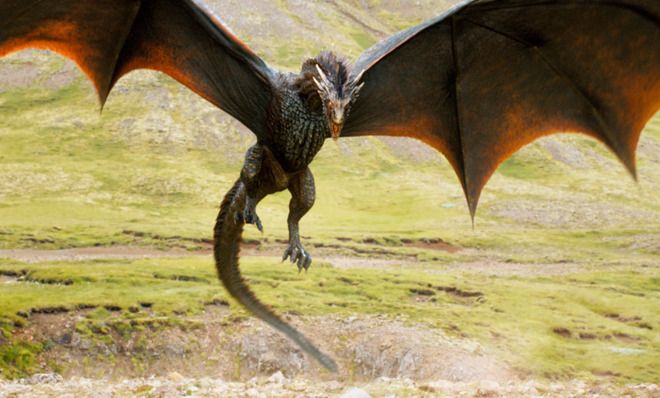12 legends that prove the whole world is obsessed with dragons
There's a lot more to dragon lore than Game of Thrones


Long before dragons were busy being the best things in Game of Thrones, the world has been telling tales about them. And guess what: they don't all end in monsters being slain and maidens being rescued.
In Iran, for instance, a dragon is chained up to this day, waiting to break free and bring the apocalypse. In Japan, another one's busy ruling the sea. The Chinese would ask why you'd even consider trying to kill such an auspicious creature, and the Vietnamese call a dragon dad. In India, a dragon stole the rains, and in Australia, one gives them back.
Almost anywhere in the world you look, in fact, there be dragons. Here's the proof.
Subscribe to The Week
Escape your echo chamber. Get the facts behind the news, plus analysis from multiple perspectives.

Sign up for The Week's Free Newsletters
From our morning news briefing to a weekly Good News Newsletter, get the best of The Week delivered directly to your inbox.
From our morning news briefing to a weekly Good News Newsletter, get the best of The Week delivered directly to your inbox.
1. Greece
It's thanks to the Ancient Greeks that dragons are dragons: it was their word drakon ("serpent") that gave us the name we use today. And their specimens certainly lived up to it. They were pretty much everything you'd want from a good dragon, i.e., horrifying and nigh impossible to slay — unless you just happen to be a hero with the gods on your side.
Take Hydra, for instance, the gigantic sea serpent that breathed and bled poison, and would grow two more heads for each one cut off. (Hercules worked out he could stop the heads sprouting by sealing each stump with fire.) Or Cetus, the sea monster that Poseidon sent to eat the princess Andromeda after her mother boasted that she was more beautiful than any sea nymph. (Perseus swooped in with his flying sandals and killed it, and the gods memorialized the story in the stars.)
Or the Ismenian dragon, son of the god of war, who guarded a sacred spring. (Cadmus killed it and planted its teeth in the ground, where they turned into fearsome warriors who would help him found the city of Thebes.) Then there was the dragon at Colchis that watched over the magical Golden Fleece. The creature never slept or even closed its eyes, but the sorceress Medea helped Jason to steal the treasure by bewitching the dragon unconscious. Incidentally, some legends say that on his way back to Greece, Jason ran into and slew another dragon, in what's now Slovenia. That's why the capital Ljubljana has a dragon on its coat of arms.
Sign up for Today's Best Articles in your inbox
A free daily email with the biggest news stories of the day – and the best features from TheWeek.com
2. China
Head east and you'll find a very different story. China might just be the best place in the world to be a dragon: you symbolize strength and bring blessings, you have all kinds of powers over the natural world, and there are pictures of you everywhere. You're one of the 12 animals of the zodiac and one of the four creatures of the constellations.
Ok, so you look a little odd: you have the horns of a stag, the head of a camel, the eyes of a demon, the belly of a shellfish, the scales of a carp, the claws of an eagle, the feet of a tiger, and the ears of an ox. But whatever — you and your type control night and day (torch dragon Zhulong makes daylight by opening his eyes, darkness by closing them), the weather (spirit dragon Shenlong decides when to bring rain), rivers and lakes (Earth dragon Dilong governs the waterways), and the Earth's most precious treasures (guard dragon Fucanlong watches over riches deep underground, bursting out now and then as a volcano). Four of you rule the oceans — the dragon kings of the north, south, east, and west seas, who live in underwater palaces made of crystal — and one of you, Tianlong the heavenly dragon, guards the gods in the sky (you can see him coiled around the North Star). The earliest Chinese emperors claimed kinship with you and almost all of them wanted you as their emblem. Even today, people will parade models of you through the streets for good fortune. It's a dragon's life.
3. Wales: Draig Goch
If anyone can give the Chinese a run for their dragon-blessed money, it's the Welsh. A Draig Goch ("red dragon") is their national symbol — and boy, oh boy are these people proud of it. The association dates back to the days when strange, poisonous reptiles thrashed the waters, haunted the air, and shook the earth of the British Isles.
The people had all sorts of amusing olde Ynglishe names for them, from knuckers to wyverns, gwibers to loathly worms, and they were forever being shot with burning arrows or having their heads chopped off. So, when King Ludd of Britain finds his kingdom cursed each May Day by an eerie shriek that causes crops to fail and women to miscarry, and his brother Llefelys, king of France, tells him that the sound comes from two battling dragons, Ludd finds that a perfectly plausible explanation. On his brother's advice, he digs a vast pit, fills it with mead, and covers it over with a cloth. The dragons — one red, one white — fall in, break from their fight to drink all the wine, and fall fast asleep. Ludd wraps them in the cloth and buries them under the peaks of Snowdonia, in northern Wales.
Centuries later, the Celtic king Vortigern wants to build a castle on that very spot. Try as he might, before each dawn any walls he lays are in ruins. His advisers tell him to find a boy with a supernatural father and spill his blood over the foundations. But the boy he chooses — who, wouldn't you know, turns out to be the legendary wizard Merlin — informs him that his troubles are caused by the two dragons trapped under his fortress, and he should set them free to finish their battle. Vortigern digs under the castle, the two dragons appear, and, after a fierce fight, the red defeats the white. Merlin explains that the white dragon represents the English and the red, the Welsh — who will rise up and drive out the invaders. We're still waiting.
4. Peru: Amaru
It's hardly surprising that the Incas, living among anacondas and crocodiles, should speak of a powerful scaly creature that emerges from the depths. Unlike your normal reptile, however, the amaru of Incan legend had two heads and were the heralds of sudden, cataclysmic change.
On their serpent's body, some had the heads of llamas or of pumas, the feet and wings of birds, and one was described as "half a league long... with ears, fangs, and a beard." They would appear from mountains, caves, and underground rivers and were associated with the coming of the rains. Some stories have them fighting and killing — like the tale of the battle between the gods of the Andes, when the volcano Huallallo Caruincho unleashes a mighty amaru on his rival, the mountain Paria Caca, who stabbed the dragon in its back with his golden staff and turned it to stone — but amaru are best known for something much nicer: the rainbow. Incas believed the creatures burst out of springs filled up with water and plunged one of their heads into another spring, where it would suck the water across. The arch we see in the sky is the spray passing between the amaru's two mouths.
5. Australia: Rainbow Serpent
Are we sure the Incas never met the first Australians? Like the early South Americans, Australia's indigenous people believed that the rainbow was a supernatural serpent with the power to control water, weather, and thus life. In fact the same association occurs in so many different myths, among so many peoples and on so many continents, that some academics have argued that all our stories about dragons are our ancestors' attempts to explain the rainbow.
Different Aboriginal Australians have different versions of the myth. Some say the Rainbow Serpent descended from an even bigger snake in the sky, still visible at night as a dark streak across the southern Milky Way. Some say the ups and downs of the land are the tracks left by the Serpent's windings, the lakes and rivers where it tickled the frogs and made them laugh, causing them to spew out the water they had drunk. Most agree that it lives in the underground waterways of the Earth, leaving them to bring rain when benevolent and storms when angry. When it travels, it arches from one waterhole to another as a rainbow. Sticklers might say that the Rainbow Serpent is more of a snake than a dragon — but since Australia is home to more actual dragons doing actual dragon stuff than perhaps any other country, we think it deserves a pass.
6. India: Vritra
What dragons giveth, dragons taketh away. Like its cousins elsewhere, India's legendary dragon ruled the waters — and it didn't want to share them.
Vritra, "the enveloper," was a huge dragon said to be the son of the primordial water goddess Danu. He trapped all seven sacred rivers within a single mountain, which he guarded jealously with his long coils. No streams flowed and no rain fell. Then came the mighty Indra, king of the gods, to save the world from its drought. Armed with a thunderbolt, he went to each of the dragon's 99 fortresses and destroyed every one until he found Vritra himself. The two fought a brutal battle. One version says that the dragon broke Indra's jaws but he managed to recover and destroy Vritra with his thunderbolt. Another says Vritra swallowed Indra whole but the other gods forced him to spew him out, in exchange for Indra's promise that he wouldn't attack the dragon at day or at night, with nothing dry and with nothing wet, nor with anything made of wood, metal or stone. Cunning Indra used the foam from the ocean waves — invested with the power of the supreme being Vishnu — to strike Vritra at twilight, keeping his promise but destroying the dragon. And now the waters of the world run free.
7. Vietnam
Vietnamese people are dragons. Correction: dragon-fairy super hybrids. The story goes that legendary king Lac Long Quan was the son of dragons, risen from the sea. Venturing onto land in his human form, he performed various heroic feats and eventually seduced Au Co, the daughter of a mountain spirit. She lay 100 eggs from which would hatch 100 sons. Lac Long's dragon nature drew him back to the ocean, where he took 50 of their children. The other 50 lived with Au Co in the mountains, and between them they founded the first dynasty of Vietnam. Dragons have been a symbol of royalty and strength ever since.
8. Japan: Ryujin
It took four Chinese dragons to rule the ocean, but Japan had only one: Ryujin, the dragon king. He was to be found at the bottom of the Sea of Japan in a spectacular underwater palace made of red and white coral. Ryujin lived there with his daughters — who, like him, had the power to switch between dragon and human form — and the turtles, fish, octopi, and other sea creatures that were his servants. It was also where he kept the magical jewels with which he controlled the tides: a white gem to make the waters retreat and a blue one to make them rise.
Many stories about Ryujin concern various humans' attempts to obtain his treasure, but it's the tale of the jellyfish that gives the best insight into his character. The jellyfish, once a normal-looking fish and faithful servant of Ryujin, was instructed by his dragon master to fetch him a monkey's liver, which the sea god was convinced would help relieve a nasty rash that was bothering him. The jellyfish dutifully tracked down a monkey, who informed him that he'd, um, left his liver in a jar somewhere and would absolutely do his best to find it and deliver it to Ryujin himself. Needless to say he did not, and when the not-very-bright jellyfish told Ryujin what had happened, the furious dragon beat it into a blob. And so it has remained.
9. France: The Tarasque
Ok, before you say anything — we know. We know this...thing is hardly a fearsome beast. In fact, it's undeniably wacky and even, dare we say it, kind of pathetic. But there's a reason for that. If ever there were a dragon tragedy, then the tale of Saint Martha and the Tarasque is it.
Our scene is the town of Tarascon in the south of France, in the first century. At this time, according to legend, the region was plagued by "a dragon which was half animal and half fish, bigger than a cow, longer than a horse and with teeth like sword-shaped horns and armed with two shields." It was known as the Tarasque and it lived in a marsh near the River Rhone, where it would help itself to passing townsfolk. Then came Martha, freshly washed up in France from Judea along with Mary Magdalene, Lazarus, and a boatful of other saints (um, sure, why not). Unafraid, Martha showed the creature her cross, sprinkled it with holy water, sang it prayers and hymns, tied her sash around its neck and led it back to the town, tame as a lamb. But before you could say "pet dragon," the panicky villagers attacked the Tarasque — which, by now so docile it didn't fight back, was soon killed. Martha gave them a lecture on Christianity (and, we hope, the importance of not needlessly murdering mythical creatures) and the whole town promptly converted. Their descendants reenact the story to this day, parading a model Tarasque through the streets each June. The tale also sets the tone for most western European legends about dragons: bloodthirsty monster terrifies pagans, fearless saint arrives to defeat it, grateful pagans convert, everybody loves Jesus. Yay!
10. Iran: Azi Dahaka
If the Tarasque has got you thinking that maybe dragons can be kind of, sort of, maybe, sometimes cute, let Azi Dahaka set you straight. He comes from Persian mythology and there's no question this creature is mean. The Avesta, the ancient sacred texts of Zoroastrianism, describe him as having three heads, three mouths, six eyes, and 1,000 skills. His name means "dragon" or "serpent" (azi) and possibly "burning," "manlike," "huge," or "foreign" (dahaka). Oh, and in case there was still doubt as to which side he's on, he was created by the force of destruction and evil.
We first hear of him and his brother attacking the mythical King Yima: they cut him in half with a saw, but the divine fire spirit Atar, created by the force of good, intervenes. Atar threatens to blow holy flames up Azi Dahaka's nether regions and out his three mouths; Azi Dahaka sensibly withdraws. He plots. He reappears to offer sacrifices to the divinities of the waters and the storm winds, asking them to help him just, you know, kill the entire human population. They decline and instead help the hero Fereydun to defeat Azi Dahaka in battle. The first blows he strikes on the dragon with his mace send snakes and insects and other nasties scurrying out from the wounds — so, advised by the gods not to strike again and risk unleashing a plague upon the world, Fereydun chains him up alive on Mount Damavand. Legend has it that one day, when the end is nigh, Azi Dahaka will break free and lay waste to a third of humanity. Even today, in Persian dragons are called azhdaha after their earliest and scariest ancestor.
11. West Africa: Bida
The Soninke people of West Africa tell the story of Bida, a magical dragon that encircled the city of Wagadu in what was once the Ghana Empire (now Mali and Mauritania). There are several versions, but the gist seems to be that Bida had the power to make gold rain down upon the city — which he did, three times a year, in exchange for the sacrifice of local maidens.
One year a young woman named Sia Jatta Bari, the most beautiful in all Wagadu, was chosen to be given to Bida. But her lover, Mamadi Sefe Dekote, was determined to save her — even if it cost the city its riches. He accompanied Sia to the dragon's lair and, knowing that Bida — evidently a showman — would always stick his head out of the cave three times before taking his prey, struck off the creature's head with his sword on the third go. The severed head flew through the air and with its dying breath vowed that Wagadu would not see golden rain for seven years, seven months, and seven days (a curse that led the ungrateful locals to chase Mamadi out of town and into more adventures, but that's another story). When the dragon's head finally fell to earth, much further south, it sowed the ground with gold. That's why, where modern-day Ghana meets the sea, you find the Gold Coast.
12. Poland: Smok Wawelski
Eastern Europe loves it some dragons, and we suspect that Bida might have got along with one of the most famous of them: Smok Wawelski, the "Wawel dragon" that once terrorized the Polish city of Krakow. The creature lived in a cave under Wawel Hill, on the banks of the Vistula River. Some say he demanded a certain number of cattle each day and if the offering fell short, he'd eat the equivalent number of humans. Others say he went on daily rampages, snacking indiscriminately on unfortunate livestock or its even more unfortunate owners. Still others say his favorite food was female virgins and he consumed the town's entire population thereof until only the king's beloved daughter was left.
Whichever version you prefer, Smok Wawelski was one crazy beast, and a pain in Krakow's collective ass. Fame and fortune was promised to whoever could rid the city of the dragon, and thus some enterprising individual — either King Krakus, his son, or a canny cobbler's apprentice, depending on who you believe — came up with a cunning plan. He took a dead lamb, stuffed it with sulfur and left it tantalizingly outside the dragon's den, where sure enough, the monster gobbled it up. No sooner had he swallowed than he felt an agonizing burn. He rushed down to the Vistula and gulped down the waters, drinking, drinking, drinking until — boom. Exploded dragon. Krakowites are much fonder of old Smok Wawelski now that he's dead, commemorating him by hanging his bones (NB: probably not his bones) outside their cathedral, offering tours of his cave, and erecting a fire-breathing statue at the foot of his hill. There's even a dinosaur named after him.
This article, by Jessica Phelan, originally appeared at GlobalPost.
More from GlobalPost...
-
 Thailand's makeover into White Lotus-inspired glamour
Thailand's makeover into White Lotus-inspired glamourThe Week Recommends The location for season three of the hit HBO series is spurring a luxury 'tourism frenzy'
By Irenie Forshaw, The Week UK Published
-
 Axel Rudakubana: how much did the authorities know about Southport killer?
Axel Rudakubana: how much did the authorities know about Southport killer?Today's Big Question Nigel Farage accuses PM of a cover-up as release of new details raises 'very serious questions for the state about how it failed to intervene before tragedy struck'
By The Week UK Published
-
 The princess and the PR: Meghan Markle's image problem
The princess and the PR: Meghan Markle's image problemTalking Point A tough week for the Sussexes has seen a familiar tale of vitriol and invective thrown the way of the actor-cum-duchess
By Jamie Timson, The Week UK Published